Digital transformation has become pivotal in reshaping how organisations operate in our increasingly digital world. In an era marked by rapid technological advancements and shifting market dynamics, embracing digital transformation is not just a strategic advantage but a necessity for staying competitive, relevant, and successful.
Particularly in sectors like oil and gas, the adoption of cutting-edge technologies such as digital twins heralds a new age of data analysis, risk management, and decision-making, propelling operational efficiency and safety to unprecedented levels.

This journey towards digitalisation, however, demands a well-structured approach. Organisations aspiring to harness the full potential of digital transformation need to navigate this path methodically, ensuring that each step taken is aligned with their overarching goals and industry-specific requirements.
Structured Steps for Successful Digital Transformation
- Defining the Vision: Start your digital transformation by setting a clear vision and strategy. This step involves outlining what you aim to achieve through the transformation and pinpointing the business processes that need digitalisation the most.
- Evaluating the Current State: With a vision in place, assess your company's current situation. Look for areas where digital technology could make a significant impact and evaluate the existing technological infrastructure and skills within your workforce.
- Selecting and Prioritising Digital Projects: Use your assessment findings to choose and rank digital projects. This process involves picking digital technologies and solutions that align with your business needs and prioritising them based on their potential impact and complexity.
- Creating a Roadmap: Develop a detailed plan for your digital transformation. This roadmap should outline the timeline, budget, and resources required for the digital projects and define the roles and responsibilities of everyone involved.
- Partnering and Building Infrastructure: Establish the necessary technological infrastructure and systems to facilitate your digital transformation. This may include investing in new hardware and software and enhancing your workforce's skills and expertise. Selecting a reliable digitalisation partner is crucial for a smooth transition.
- Implementation and Monitoring: With the infrastructure set, implement the digital initiatives and keep track of their progress. Ensure that your workforce is equipped with the skills and training to use the new technologies effectively and monitor how these initiatives affect business performance.
- Ongoing Adaptation: Recognise that digital transformation is a continuous journey. Regularly review the effectiveness of your initiatives, seek new digitalisation opportunities, and adjust your strategy and roadmap as necessary.

The need to navigate thoughtfully
In conclusion, the journey of digital transformation in the context of modern businesses, especially in high-stakes industries like oil and gas, is complex yet indispensable. By following these structured steps, organisations can ensure that their transition into the digital era is smooth and yields sustainable benefits.
From enhancing operational efficiency to making informed decisions and mitigating risks, the path of digitalisation, when navigated thoughtfully, leads to a future where technology empowers businesses and their people to reach new heights of success and innovation. Staying agile and responsive to these changes will be critical as the digital landscape evolves.
Want to see how Aize can help?

Post written by Mads Gudim Burheim
Mads worked as a journalist and project manager in Aller Media and Schibsted for 15 years before joining Aize as Senior Content & Communications manager. He loves writing, travelling and living in Oslo.
Stay in the loop
I’d like to sign up to Aize newsletter





